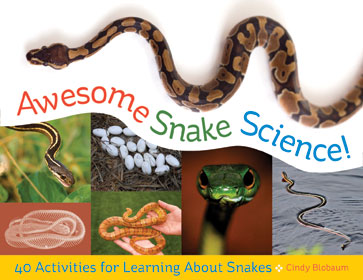Suggested reading from Chicago Review Press
 Mother's Day Mother's Day |
 Father's Day Father's Day |

 |
40 Activities for Learning About Snakes
By Cindy Blobaum
Young Naturalists
JUVENILE NONFICTION
128 Pages, 11 x 8 1/2
Formats: Trade Paper, PDF, Mobipocket, EPUB
Trade Paper, $16.99 (CA $21.99) (US $16.99)
ISBN 9781569768075
Rights: WOR
Chicago Review Press (Jul 2012)
Overview
Reviews
Author Biography
May we also suggest...
Trade Paper
Published Aug 2005
Published Nov 2005
EPUB
Published Nov 2005
Mobipocket
Published Nov 2005
Published Jul 2012
Mobipocket
Published Jul 2012
EPUB
Published Jul 2012
Trade Paper
Published Jan 2015
AAAS Subaru SB&F Excellence in Science Finalist 2016
NSTA-CBC Outstanding Science Trade Books for Students K-12 2016
An engaging book that encourages young nature enthusiasts to explore the world of birds
This generously illustrated, full-color book teaches kids that birds can be seen almost anywhere: in city parks and streets, zoos, farms, and backyards. Using “Try This,” “Look For,” and “Listen For” prompts, Birdology promotes independent observation and analysis, writing and drawing skills, and nature literacy. Kids observe the diversity of shapes, colors, patterns, and behavior of birds; listen for their songs and the clap of wings; make a juice-box feeder; plant flowers that attract hummingbirds; start a birding journal and sketchbook; and much more. Other topics that are presented in clear, kid-friendly prose include migration, nesting, food, territories, and conservation and preservation. Additional resources, such as a glossary, bird orders and scientific names, bird and wildlife organizations, and “Teacher Topics” to initiate classroom discussion and investigation, are also included.
EPUB
Published Jan 2015
AAAS Subaru SB&F Excellence in Science Finalist 2016
NSTA-CBC Outstanding Science Trade Books for Students K-12 2016
An engaging book that encourages young nature enthusiasts to explore the world of birds
This generously illustrated, full-color book teaches kids that birds can be seen almost anywhere: in city parks and streets, zoos, farms, and backyards. Using “Try This,” “Look For,” and “Listen For” prompts, Birdology promotes independent observation and analysis, writing and drawing skills, and nature literacy. Kids observe the diversity of shapes, colors, patterns, and behavior of birds; listen for their songs and the clap of wings; make a juice-box feeder; plant flowers that attract hummingbirds; start a birding journal and sketchbook; and much more. Other topics that are presented in clear, kid-friendly prose include migration, nesting, food, territories, and conservation and preservation. Additional resources, such as a glossary, bird orders and scientific names, bird and wildlife organizations, and “Teacher Topics” to initiate classroom discussion and investigation, are also included.
Mobipocket
Published Jan 2015
AAAS Subaru SB&F Excellence in Science Finalist 2016
NSTA-CBC Outstanding Science Trade Books for Students K-12 2016
An engaging book that encourages young nature enthusiasts to explore the world of birds
This generously illustrated, full-color book teaches kids that birds can be seen almost anywhere: in city parks and streets, zoos, farms, and backyards. Using “Try This,” “Look For,” and “Listen For” prompts, Birdology promotes independent observation and analysis, writing and drawing skills, and nature literacy. Kids observe the diversity of shapes, colors, patterns, and behavior of birds; listen for their songs and the clap of wings; make a juice-box feeder; plant flowers that attract hummingbirds; start a birding journal and sketchbook; and much more. Other topics that are presented in clear, kid-friendly prose include migration, nesting, food, territories, and conservation and preservation. Additional resources, such as a glossary, bird orders and scientific names, bird and wildlife organizations, and “Teacher Topics” to initiate classroom discussion and investigation, are also included.
Published Jan 2015
AAAS Subaru SB&F Excellence in Science Finalist 2016
NSTA-CBC Outstanding Science Trade Books for Students K-12 2016
An engaging book that encourages young nature enthusiasts to explore the world of birds
This generously illustrated, full-color book teaches kids that birds can be seen almost anywhere: in city parks and streets, zoos, farms, and backyards. Using “Try This,” “Look For,” and “Listen For” prompts, Birdology promotes independent observation and analysis, writing and drawing skills, and nature literacy. Kids observe the diversity of shapes, colors, patterns, and behavior of birds; listen for their songs and the clap of wings; make a juice-box feeder; plant flowers that attract hummingbirds; start a birding journal and sketchbook; and much more. Other topics that are presented in clear, kid-friendly prose include migration, nesting, food, territories, and conservation and preservation. Additional resources, such as a glossary, bird orders and scientific names, bird and wildlife organizations, and “Teacher Topics” to initiate classroom discussion and investigation, are also included.
Trade Paper
Published Sep 2016
Published Sep 2016
Mobipocket
Published Sep 2016
EPUB
Published Sep 2016
Trade Paper
Published Feb 2019
Mobipocket
Published Feb 2019
Published Feb 2019
EPUB
Published Feb 2019
EPUB
Published Jan 2020
Published Jan 2020
Mobipocket
Published Jan 2020
Trade Paper
Published Jan 2020
Trade Paper
Published Apr 2021
EPUB
Published Apr 2021
Published Apr 2021
Mobipocket
Published Apr 2021
Trade Paper
Published Jul 2022
Published Jul 2022
EPUB
Published Jul 2022